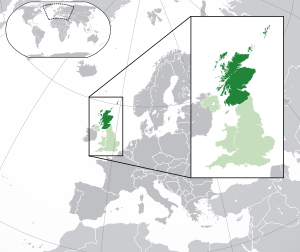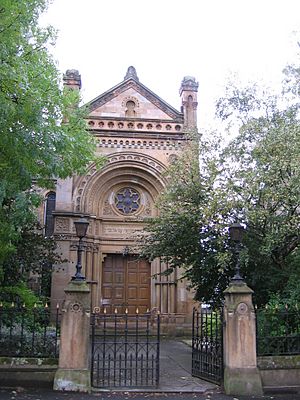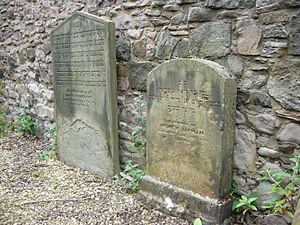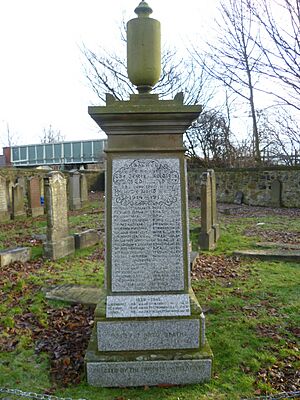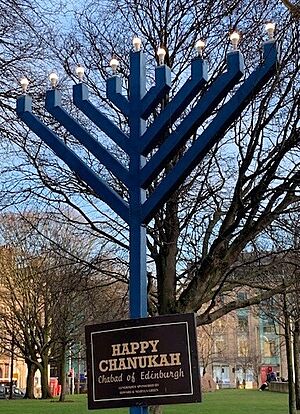History of the Jews in Scotland facts for kids
| Total population | |
|---|---|
| 5,887 (according to 2011 census) | |
| Regions with significant populations | |
| East Renfrewshire, Edinburgh, Glasgow, Dundee | |
| Languages | |
| Scottish English, Scots, Scottish Gaelic, Hebrew, Yiddish | |
| Religion | |
| Judaism |
The history of the Jews in Scotland tells the story of Jewish people living in Scotland. We know they have been there since at least the 17th century. It is not clear exactly when the first Jewish people arrived in Scotland. The oldest clear records of Jewish people in Scotland are from the late 1600s.
Most Jewish people in Scotland today are from an Ashkenazi background. They mostly settled in Edinburgh first, then in Glasgow in the mid-1800s. In 2013, a group called the Edinburgh Jewish Studies Network created an online exhibition. It showed how the Jewish community influenced the city.
The 2011 census counted 5,887 Jewish people living in Scotland. This was a small decrease from the 2001 census. At that time, Scotland's total population was about 5.3 million. This means Jewish people made up about 0.1% of the population.
Contents
Early Jewish Life in Scotland
There is not much proof of Jewish people in Scotland during the Middle Ages. In 1180, a bishop in Glasgow told churchmen not to borrow money from Jews. This was around the time of anti-Jewish riots in England. So, it's possible Jewish people came to Scotland as refugees. Or, it might have meant Scottish people were borrowing from Jews living in England.
During the Middle Ages, Scotland traded a lot with other parts of Continental Europe. Wool from the Borders was a main export to places like Flanders. Scottish traders from Aberdeen and Dundee also traded with ports in Poland and Lithuania. It is possible that Jewish traders came to Scotland for business. However, there is no direct proof of this.
Jewish Communities Grow (17th-19th Centuries)
The first Jewish person recorded in Edinburgh was David Brown in 1691. He was allowed to live and trade in the city.
Most Jewish people came to Scotland after the country became more industrial. This was also after 1707, when Scotland joined with England to form Great Britain. At this time, Jewish people in Scotland were under the same laws as those in the rest of Britain. Oliver Cromwell allowed Jews back into England in 1656. This also affected whether they could live in Scotland.
Scottish university students did not have to take a religious oath. This was different from England. Joseph Hart Myers, from New York, was the first Jewish student to study medicine in Scotland. He graduated from the University of Edinburgh in 1779. Levi Myers was the first openly Jewish graduate from the University of Glasgow in 1787.
In 1795, Herman Lyon, a dentist, bought a burial plot in Edinburgh. He was from Germany and moved to Scotland in 1788. This burial plot on Calton Hill is not easy to see today. But it was marked on old maps as "Jew's Burial vault."
The first Jewish community in Edinburgh began in 1817. At that time, there were 20 Jewish families in the city. The first community in Glasgow started in 1821. Many of the first Jewish people to come to Scotland were Dutch and German traders. They were drawn to the business opportunities in Scottish cities.
Isaac Cohen, a hat maker in Glasgow, became a citizen of the city in 1812. The first burial in the Glasgow Necropolis was Joseph Levi, a quill merchant. He was buried there in 1832. This happened before the cemetery officially opened. A part of it had been sold to the Jewish community. Glasgow-born Asher Asher (1837–1889) was the first Scottish Jew to become a doctor.
The story of one Jewish family's experience was told in Jack Ronder's book and TV series called The Lost Tribe.
In 1878, Hannah de Rothschild (1851–1890) married a Scottish nobleman. She was Jewish and the richest woman in Britain then. They had four children. Their son, Harry, later became a government minister for Scotland in 1945.
Many Jewish people came to Scotland in the 1880s to escape harm in the Russian Empire. They settled in bigger cities like Glasgow. They often lived in the poorer area called the Gorbals. Smaller groups settled in Edinburgh, Dundee, and Aberdeen. Many of these Jewish people came from areas like Lithuania and Poland. They often saw Scotland as a stop on their way to North America. But if they could not earn enough money for the trip, they stayed in Glasgow. By 1897, Glasgow's Jewish population was 6,500.
This second group of Jewish immigrants was much larger. They came from Eastern Europe, not Western Europe. This led to a difference between the "Westjuden" and "Ostjuden." The "Westjuden" were often middle class and fit into Scottish society. The "Ostjuden" were poorer and spoke Yiddish. They had fled difficult situations in Eastern Europe.
The "Westjuden" lived in richer areas like Garnethill in Glasgow. The Garnethill Synagogue was built there between 1879 and 1881. It is the oldest active synagogue in Scotland. It now also holds the Scottish Jewish Archives Centre. The "Ostjuden" mostly lived in the poorer areas of the Gorbals. This led to the building of the South Portland Street Synagogue in 1901. It was seen as the main religious center for many years.
Jewish Life in the 20th and 21st Centuries
More Jewish people arrived in Scotland in the early 1900s. There were over 9,000 in 1901 and about 12,000 in 1911. Jewish life in the Gorbals in Glasgow was at first like traditional "shtetl" life (small Jewish towns). But people worried this might cause more anti-Jewish feelings. So, the Jewish community created groups to help refugees. These groups helped them fit into Scottish society.
In Edinburgh, the Jewish Literary Society was started in 1888. Its goal was to teach British culture to Jewish immigrants. It is still active today, but with a different focus. The Aliens Act 1905 and World War I caused fewer Jewish refugees to come to Scotland.
In Edinburgh, Rabbi Dr. Salis Daiches helped unite different Jewish groups in 1918. He brought together the older, more British Jewish people and the newer, Yiddish-speaking immigrants. Rabbi Daiches also worked to build good relationships between the Jewish community and others. Because of his efforts, money was raised to build the Edinburgh Synagogue. It opened in 1932 and was the only synagogue built for that purpose in the city.
Jewish people fleeing Nazi Germany and the Second World War also came to Scotland. It is thought that the Scottish Jewish community grew to over 20,000 people in the mid-1900s.
Whittinghame Farm School was a safe place for 160 children from 1939 to 1941. These children came to Britain as part of the Kindertransport mission. The school was in Whittinghame House, the home of the Earl of Balfour. The children learned farming skills. The idea was that they would settle in Palestine after the war.
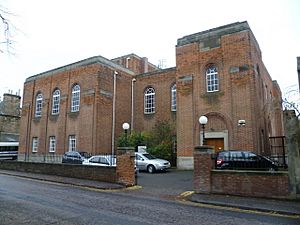
The number of Jewish people who actively practice their faith continues to decrease in Scotland. Many younger Jewish people have become less religious. Some have also married people of other faiths. Many Scottish Jews have moved to England, the United States, Israel, Canada, Australia, and New Zealand. They moved for economic reasons, just like other Scots.
The 2011 census showed 5,887 Jewish people in Scotland. About 41% (2,399) of Scottish Jews live in East Renfrewshire. This area is part of Greater Glasgow. About 25% of Scottish Jews live in the Glasgow suburb of Newton Mearns alone. Many Jewish families slowly moved from central Glasgow to these richer suburban areas over the years. Glasgow city itself has 897 Jewish people. Edinburgh has 855. The Outer Hebrides had the fewest, with only 3 Jewish people reported.
In 2008, a Jewish tartan was designed by Brian Wilton for Rabbi Mendel Jacobs of Glasgow. It was approved by the Scottish Tartans Authority. The tartan's colors are blue, white, silver, red, and gold. The blue and white represent the flags of Scotland and Israel. The gold line represents gold from the Bible. The silver is from decorations on the Torah. The red stands for the traditional red Kiddush wine.
The Scottish Council of Jewish Communities represents Jewish communities in Scotland.
Antisemitism in Scotland
In the Middle Ages, Jewish people in England faced persecution. This led to their expulsion in 1290. But there was no such expulsion from Scotland. This might mean there was more religious tolerance in Scotland. Or, it might simply mean there were no Jewish people living there at that time. A Scottish-Jewish writer, David Daiches, wrote that his father often said Scotland was one of the few European countries with no history of state persecution of Jews.
In the 1930s, some groups like the British Union of Fascists had anti-Jewish views. One of their main thinkers, Alexander Raven Thomson, was Scottish. Meetings of this group were sometimes attacked in Edinburgh. This was by people who thought the group was too Catholic. A historian from Dundee University suggested that anti-Catholic feelings in Glasgow might have taken attention away from Jewish people.
During the 1930s, Jewish leaders in Glasgow tried to avoid drawing attention to the Jewish population. They wanted to encourage Jewish people to fit into Scottish society. This was similar to national Jewish leadership. However, the Edinburgh Jewish Representative Council was more active in asking for help for German Jews.
In 2012, a report said there was a "toxic atmosphere" for Jewish students at the University of Edinburgh. It said Jewish students felt they had to hide their identity.
In 2013, the Scottish Council of Jewish Communities published a report called "Being Jewish in Scotland." It found that some Jewish people had experienced anti-Jewish behavior at work, university, and school. In 2011, there were 10 incidents of abusive behavior, 9 incidents of damage to Jewish property, and one assault.
During the Operation Protective Edge in 2014, there was a sharp rise in anti-Jewish incidents in Scotland. In one week in August, there were 12 incidents. This was almost as many as in all of 2013. The Scottish government reported an increase in charges for anti-Jewish acts. These mostly involved "threatening and abusive behavior."
Anti-Jewish feelings continue to be discussed in Scotland. In 2017, the Scottish Government officially adopted a definition of anti-Semitism.
"Scots-Yiddish" Language
Scots-Yiddish is a special mix of the Scots and Yiddish languages. It was used for a short time in the Lowlands in the first half of the 20th century. The Scottish writer David Daiches described it in his book about his Jewish childhood in Edinburgh.
Daiches explained that Edinburgh's Jewish society had different groups. One group was well-educated and fit into Scottish society. They mixed Jewish religious ideas with modern thinking. The other group spoke Yiddish and preferred to keep their Eastern European traditions. The Yiddish-speaking population grew in Scotland in the 1800s. But by the late 1900s, most had switched to speaking English. So, Scots-Yiddish was mainly spoken in the middle of this period.
Daiches said that traveling salesmen called "trebblers" spoke this language. They traveled by train to towns in Fife, selling their goods. He noted that Scots keeps some German words that English lost, but Yiddish still has. For example, "licht" for light or "lift" for air.
The Glasgow Jewish poet A C Jacobs also called his language Scots-Yiddish. Another writer, Avrom Greenbaum, published some Scots-Yiddish poems in the Glasgow Jewish Echo in the 1960s. These are now kept at the Scottish Jewish Archives Centre. In 2020, the poet David Bleiman won a prize for his poem "The Trebbler's Tale." It was written in a mix of Scots and Yiddish.
Famous Scottish Jews
- Ronni Ancona, comedian
- Jenni Calder, writer
- Hazel, Lady Cosgrove, first female judge in the Court of Session
- Ivor Cutler, musician and comedian
- Noam Dar, professional wrestler
- Sir Monty Finniston, industrialist
- Hannah Frank, artist and sculptor
- Myer Lord Galpern, politician and Lord Provost of Glasgow
- Ralph Glasser, psychologist and economist (grew up in Glasgow)
- Professor Sir Abraham Goldberg, leading medical academic
- Muriel Gray, author and TV presenter
- Jeremy Isaacs, broadcaster, born in Glasgow
- A C Jacobs, poet
- Mark Knopfler, co-founder of Dire Straits
- Kevin Macdonald, film director
- Isi Metzstein, architect
- Saul Metzstein, filmmaker
- Neil Primrose, politician and soldier
- Malcolm Rifkind, politician
- Hugo Rifkind, broadcaster
- Harry, 6th Earl of Rosebery, government minister for Scotland
- Jerry Sadowitz, comedian and conjurer
- Benno Schotz, sculptor
- Sara Sheridan, writer
- Manny Shinwell, politician
- J. David Simons, novelist
- Dame Muriel Spark, novelist
- Harry, Lord Woolf, judge, grew up in Scotland
- Scottie Wilson, artist
See Also
- History of the Jews in Ireland
- History of the Jews in Wales
- History of the Jews in England
- The Scottish Council of Jewish Communities
- List of British Jews
- List of Jewish communities in the United Kingdom


